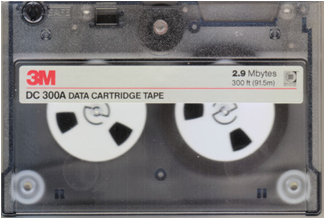Assume that an organization has bought a powerful computer to meet its growing needs. The problem now is to shift the massive databases (e.g. a collection of related files, in which an employee database can contain employee code file, attendance file, loan file, leave file, etc.) from the old machines to the new ones. Using diskettes as the backup medium is cumbersome, as they cannot store large amounts of data. In such cases, a cartridge tape is a very convenient backup media as it can store many megabytes of data. Cartridge tapes are available in capacities of 60 MB, 150 MB and 500 MB.
Cartridge Tape
A cartridge tape is made of plastic, coated with a magnetic material, and is similar to a video cassette tape. The tape is divided into tracks, which run along the entire length of the tape. Data is recorded along these tracks. Just as you need a disk drive to read or write data onto a disk, you need a cartridge tape drive which is an input-output device for a cartridge tape.
Data on a cartridge tape is stored sequentially. Therefore, if you want to access data stored at the end of the tape, you will have to run through the entire tape till you come to the end. This is in direct contrast to accessing data on disks wherein data can be accessed randomly. A good analogy here is the audio tape or the gramophone record. If you want to listen to a song recorded in the middle of the tape, you have to forward the tape till you come to the point where the song starts whereas in the gramophone record you can directly place the gramophone head on the required sound track. Cartridge tapes are used wherever the volume of data or software to be backed up is very large, for example, backup copies of DBMS. Cartridge tape drives are present only in large machines.

